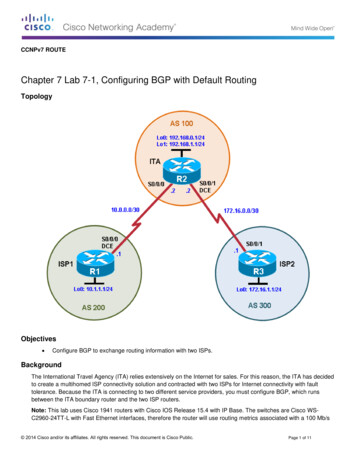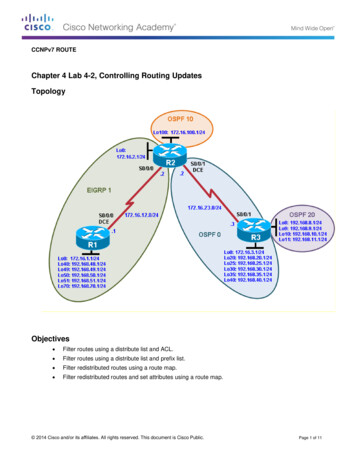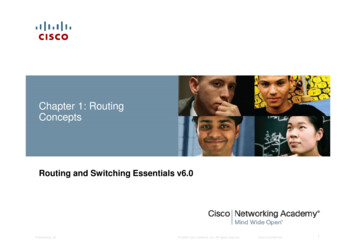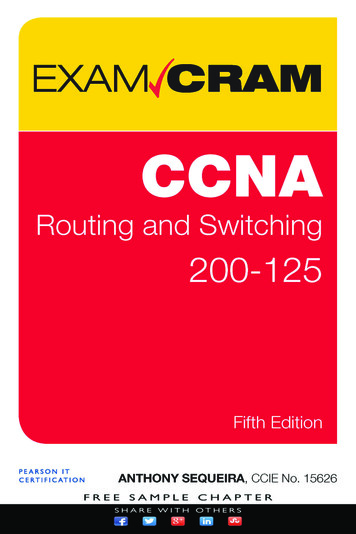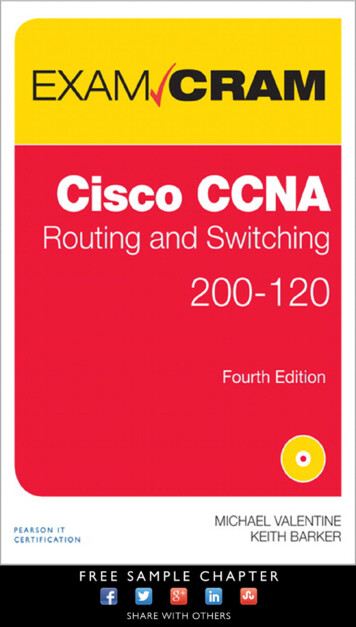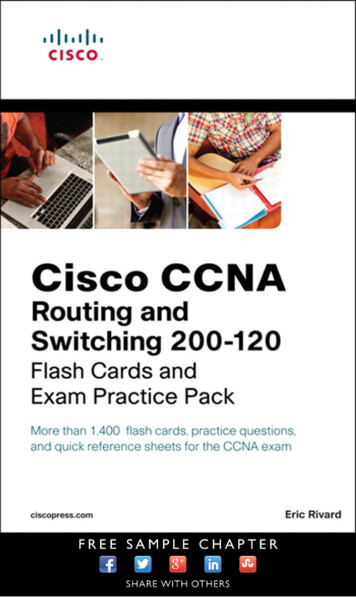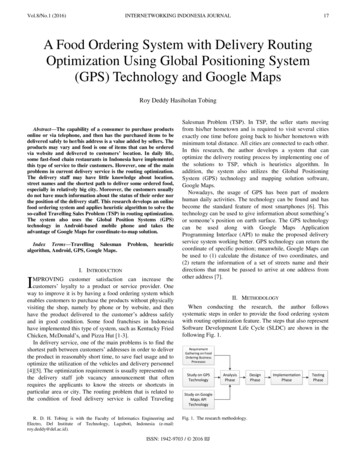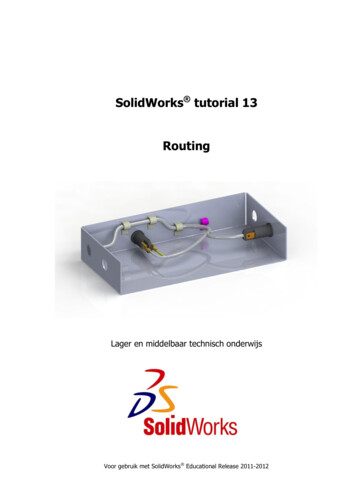
Transcription
CHAPTER 4DYNAMIC ROUTINGIn this chapter we cover the basic principles of dynamic routing algorithms that form the basis ofthe experiments in Lab 4.The chapter has six sections. Each section covers material that you need to run the lab exercises.The first section gives an overview of dynamic routing protocols and discusses the differencesbetween the two major classes of routing algorithms: intra domain and inter domain. Sections 2,3, 4, and 5 give an overview of the most common routing algorithms such , RIP, OSPF, BGP andIGRP. Section 6 presents the commands used to configure the hosts and the routers for dynamicrouting.
TABLE OF CONTENT1ROUTING PROTOCOLS . 31.1AUTONOMOUS SYSTEMS (AS) . 31.2INTRADOMAIN ROUTING VERSUS INTERDOMAIN ROUTING . 41.3DYNAMIC ROUTING . 41.3.1Distance Vector Algorithm . 42RIP . 53OSPF . 54BGP . 55TOOLS AND UTILITIES. 55.15.2CONFIGURING DYNAMIC ROUTING ON A CISCO ROUTER . 5CONFIGURING DYNAMIC ROUTING ON A LINUX PC. 8
1 Routing protocolsRouting protocols consist of communication primitives that are used explicitly for theexchange of routing information. The exchanged information is then used by a routingalgorithm to determine the optimal path to a destination and the creation of a routingtable. Many routing algorithms exist. They all differ in the information that is used tocalculate the path from a source to a destination (e.g., local versus global), the metricsand thresholds for selection, the frequency of updates, the rate of convergence, etc. In thischapter we will discuss some of the more common algorithms that have beenimplemented for route calculation between hosts and routers within a domain andbetween just routers for inter domain routing.1.1 Autonomous systems (AS)An autonomous system (AS) is an administrative entity that controls and administers anetwork of hosts and routers within a single domain. The network control and operationinside an AS is local and not subject to any external supervision. The gateway or routerthat interconnects the AS to another AS or ASs, must comply to the standard protocolsand procedures that are used to communicate between such domains. An AS mustprovide a consistent picture of its addressing space to the external world, i.e., whichhosts/IP addresses are reachable via its gateways.ASs came into being when the size of the Internet became too unwieldy. As more andmore routers were added to the Internet, it became obvious that updating and maintaininga single large network of routers was very difficult, the Internet lost its flexibility andability to adapt to changes. In the early 80’s it was decided to carve up the Internet intoadministrative domains, that would control their own network devices and use a gateway1to connect their network, called a stub, to a core network that would serve as thebackbone to connect to other stub networks (domains). Each AS is allocated a number bythe IANA. These numbers are 16 bit numbers that can be either public (in the case of anISP providing transit services) or private (a campus/corporate ystem sSystem 2RouterEthernetFigure 1. Autonomous Systems1Thus the use of the name gateway to refer to a router that connects two domains.
1.2 Intradomain routing versus Interdomain routingIntradomain routing consists of the exchange of route information between devices thatare within a single AS whereas interdomain routing consists of the exchange ofreachability information between devices that lie on the boundary of ASs. As such,interdomain routing is often referred to as a reachability protocol more so then a dynamicrouting algorithm.Intradomain routing need not follow a standard or use a single routing algorithm, itsinternal operation is hidden from the rest of the world, it can pick and chose whichalgorithms to run on its subnets. On the other hand, interdomain routing needs to followthe guidelines set forth by the Internet body so that no miscommunication can occur thatcould result in the termination of communication services between two domains. Adomain is generally a much smaller entity and easier to administer than the globalInternet. The routing protocols can therefore consist of more complex and dynamicschemes that exploit node and link state information. The interdomain routing protocolsare less adaptive, they need to converge faster and must be robust to sudden changes innetwork state. Although no dynamic algorithm is loop free (therefore the TTL field in theIP header), recovery from transients should be fast in interdomain routing algorithms.This could come at the cost of less adaptability.1.3 Dynamic routingThe role of a router and a host are very different when it comes to routing as explained inChapter 3. A host is only responsible for maintaining a routing table, it is a silent/passiveobserver of the routing process. A host listens to routing messages that are broadcast onthe local subnet (e.g. router advertisements) to fill in the necessary entries in its routingtables. A router on the other hand, is responsible for: Identifying neighbors (other routers) Discovering routes (from other routers) Selecting a route (next hop to a destination) Maintaining routing information (dynamically participating in router messageexchanges)Depending on where a router falls in the AS, it may be responsible for only interiorrouting (e.g., a router inside an AS), only exterior routing (e.g., a router in a backboneWAN) or maybe both (e.g., a gateway router, one interface is interior whereas the other isexterior).The most common dynamic routing protocols use very different algorithms for pathdetermination. The distance vector based routing algorithms exchange information onlywith its immediate neighbors and uses that to make hop by hop routing decisions, the linkstate based algorithm exchanges full state information with all the nodes in a specifiedarea, the path vector.1.3.1 Distance Vector Algorithm
2RIP3OSPF4BGP5Tools and Utilities5.1Configuring dynamic routing on a Cisco routerCisco routers support most routing protocols, including BGP, RIP, and OSPF, and can beconfigured through the Command Line Interface (CLI). Figure 2 is a brief overview ofthe IOS CLI hierarchy, indicating what commands can be entered in which mode. Similarto the configuring router interfaces, routing protocols can be configured through theRouter Configuration Mode (config-router).Figure 2: IOS CLI Hierarchy
The following table summarizes the commonly used commands to enable RIP on aCisco router.Router1(config)# router ripRouter1(config-router)#Enables the RIP routing process. This willtake you to the router configuration mode.Router1(config)# no router ripDisables the RIP routing process.Router1(config-router)# network ip netaddrAssociates network ip netaddr to RIP. RIPsends updates ONLY to the interfaces withthis network address. ip netaddr shall notinclude the subnet id. More than onenetwork can be added.Router1(config-router)# no networkip netaddrDisables RIP for the specified network.Router1(config-router)# passive-interfaceinterfaceSets the specified interface to RIP passivemode.Router1(config-router)# no passiveinterface interfaceSets the specified interface to RIP nonpassive mode.Router1(config-router)# offset-list 0 in valueinterfaceIncreases all the incoming metrics in RIPpackets received at specified interface byvalue.Router1(config-router)# offset-list 0 outvalue interfaceIncreases all the outgoing metrics in RIPpackets sent from specified interface byvalue.Router1(config-router)# no offset-list 0in/out value interfaceDisables the specified offset-list.Router1(config-router)# version 2Sets the RIP version to 2.Router1(config-router)# timers basic updateinvalid hold-down flushSets the following RIP timers:Example:Router1(config-router)# timers basic 30 180180 240Router1(config-router)# flash-updatethreshold timeupdate – the rate at which routing updatesare sent.invalid – the interval after which a route isdeclared invalid.hold-down – the interval during whichrouting information regarding better paths issuppressed.flush – the amount of time that must passbefore a route is removed from the routingtableIf the update is due in time seconds then donot send a triggered update. Thus, if time isset to a value equal to the update timerthen triggered updates are disabled.
threshold timenot send a triggered update. Thus, if time isset to a value equal to the update timerthen triggered updates are disabled.Table 1: Cisco IOS commands for RIP.The following table summarizes the commonly used commands to enable OSPF on aCisco router.Router1(config)# router ospf processidRouter1(config-router)#Enables OSPF routing process. This will take youto the router configuration mode. (Next Line)process-id is a numeric value local to the router.This enables one router to have multiple OSPFprocesses. However, in this lab, you will only useone process. Assign 1 for the process-id. Notethat it does not have to match process ids onother routers.Router1(config)# no router ospfprocess-idDisables the specified OSPF process.Router1(config-router)# networkip netaddr wildcard mask areaarea idip addr is the network address on which the OSPFprocess runs. Wildcard mask helps in reducingconfiguration lines. 0 is a match bit and 1 is a don’tcare bit. The area id is the area that interfaces arein specified by the ip addr and wildcard mask.(From the example, all interfaces whose 1st byteequals 10 belongs to area 1).Area 0 is reserved for Backbone area.Example:Router1(config-router)# network10.0.0.0 0.255.255.255 area 1Router1(config-router)# no networkip addr wildcard mask area area idDisables OSPF on the specified network area.Router1(config-router)# passiveinterface interfaceSets the specified interface (eth0) to passivemode.Router1(config-router) no passiveinterface interfaceSets the specified interface (eth0) to non-passivemode (actively participates in OSFP algorithm).Router1# show ip ospfDisplays general information about OSPFRouter1# show ip ospf databaseDisplays the link-state databaseRouter1# show ip ospf borderroutersDisplays the Area Border Router (ABR) andAutonomous System Boundary Router (ASBR).Router1# clear ip ospf process-idprocessResets the specified OSPF process.Table 2: Cisco IOS commands for OSPF.
The following table is a review of several commands available to obtain the configurationstatistics of a Cisco router.Router1# show ip routeDisplays the entries in the routing table.Router1# clear ip route *Deletes all the entries from the routingtable, except the ones associated with itsown interfaces.Router1# show ip cacheDisplays the entries in the routing cache.Router1# clear arp-cacheDeletes all the entries in the ARP table,except the ones associated with its owninterfaces.Router1(config)# ip routingEnables IP routing.Router1(config)# no ip routingDisables IP routing. This also resets the allthe configurations related to routing.Table 3: Cisco IOS commands for viewing statistics.5.2Configuring dynamic routing on a Linux PCZebra is a configuration software for managing TCP/IP based routing protocols,including RIP, OSPF, and BGP, on a Linux PC. Zebra uses multithreadtechnology under multithread supported UNIX kernels, and allows for a separateprocess to be run for each protocol. Each module (routing daemon) of zebra canbe started, stopped, configured, and upgraded independently of the others,providing protection from the failure of one protocol affecting the entire system.Supported routing protocols are:bgpdripdripngdospfdospf6dManages BGP-4 and BGP-4 protocolManages RIPv1, v2 protocolManages RIPng protocolManages OSPFv2 protocolManages OSPFv3 protocolZebra acts as a kernel routing table manager and is responsible for changing the kernelrouting table and for redistribution of routes between different routing protocols, asshown in the diagram below.
BGP daemonRIP daemonOSPF daemonZEBRA daemonUNIX Kernel Routing TableFigure 3: Zebra System ArchitectureThus, in order to properly update the kernel routing table, the zebra daemon must berunning prior to starting and configuring the routing protocols.Zebra daemons have their own configuration file which defines the default settings of eachprotocol at system boot-up, and are generally found in the directory /usr/local/etc/ or/etc/zebra/. They are basically empty since most of the features can be configureddynamically just like the Cisco routers once the daemon are running. In addition, zebradaemons have their own terminal interface or VTY, which can be connected via a telnetsession to the appropriate port number, and is defined by the file 2606/tcp#######zebra servicezebra vtyRIPd vtyRIPngd vtyOSPFd vtyBGPd vtyOSPF6d vty
On Red Hat 7.3 Linux systems, shell scripts located in /etc/rc.d/init.d/ are used tostart and stop the zebra daemons. Since these scripts can be lengthy to type, aliases havebeen created for the lab exercises to make the procedure d/init.d/ospfd/etc/rc.d/init.d/ripdArguments accepted by the above commands are:start stop restart reload condrestart statusYou may check whether the daemons are already running by using the status option:PC1% runzebra statusIf there is more than one process of each daemon running, terminate the processes by eitherusing the stop option:PC1% runzebra stopor with the pkill command:PC1% pkill zebraFor example, to set up a routing process, first start the zebra daemon, and then the routingprotocol daemon, such or ripd:PC1% /etc/rc.d/init.d/zebra startPC1% /etc/rc.d/init.d/ripd startNow connect to and configure the ripd daemon:PC1% telnet localhost 2602ripd enableripd# configure terminalripd(config)# router ripripd(config-router)# version 2ripd(config-router)# network 10.0.0.0/8ripd(config-router)# passive-interface eth0ripd(config-router)# redistribute connectedripd(config-router)# endripd# show ip ripripd# exitAs one can see, the interface and commands for the ripd daemon are similar to thoseused on a Cisco router. This is also the case for configuring other protocols withinzebra.
/univercd/cc/td/doc/product/software/ios112/112cg cr/5cbook/5ciprout.htm
Table 1: Cisco IOS commands for RIP. The following table summarizes the commonly used commands to enable OSPF on a Cisco router. Router1(config)# router ospf process-id Router1(config-router)# Enables OSPF routing process. This will take you to the router configuration mode. (Next Line) process-id


